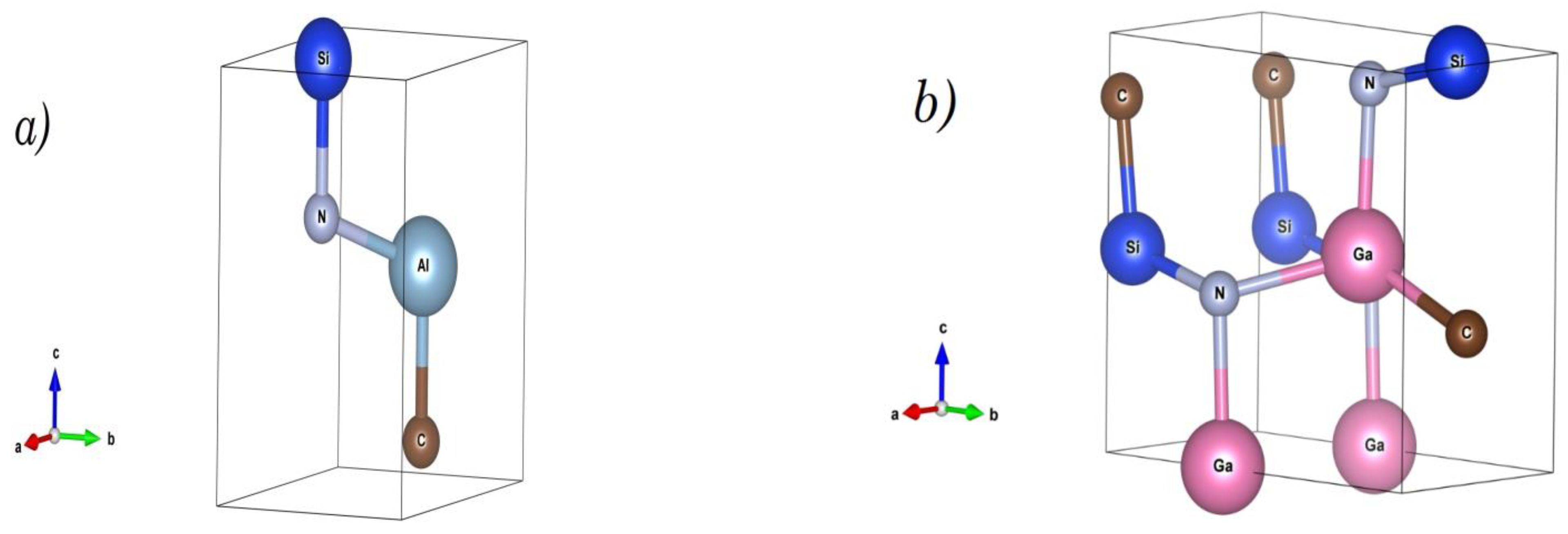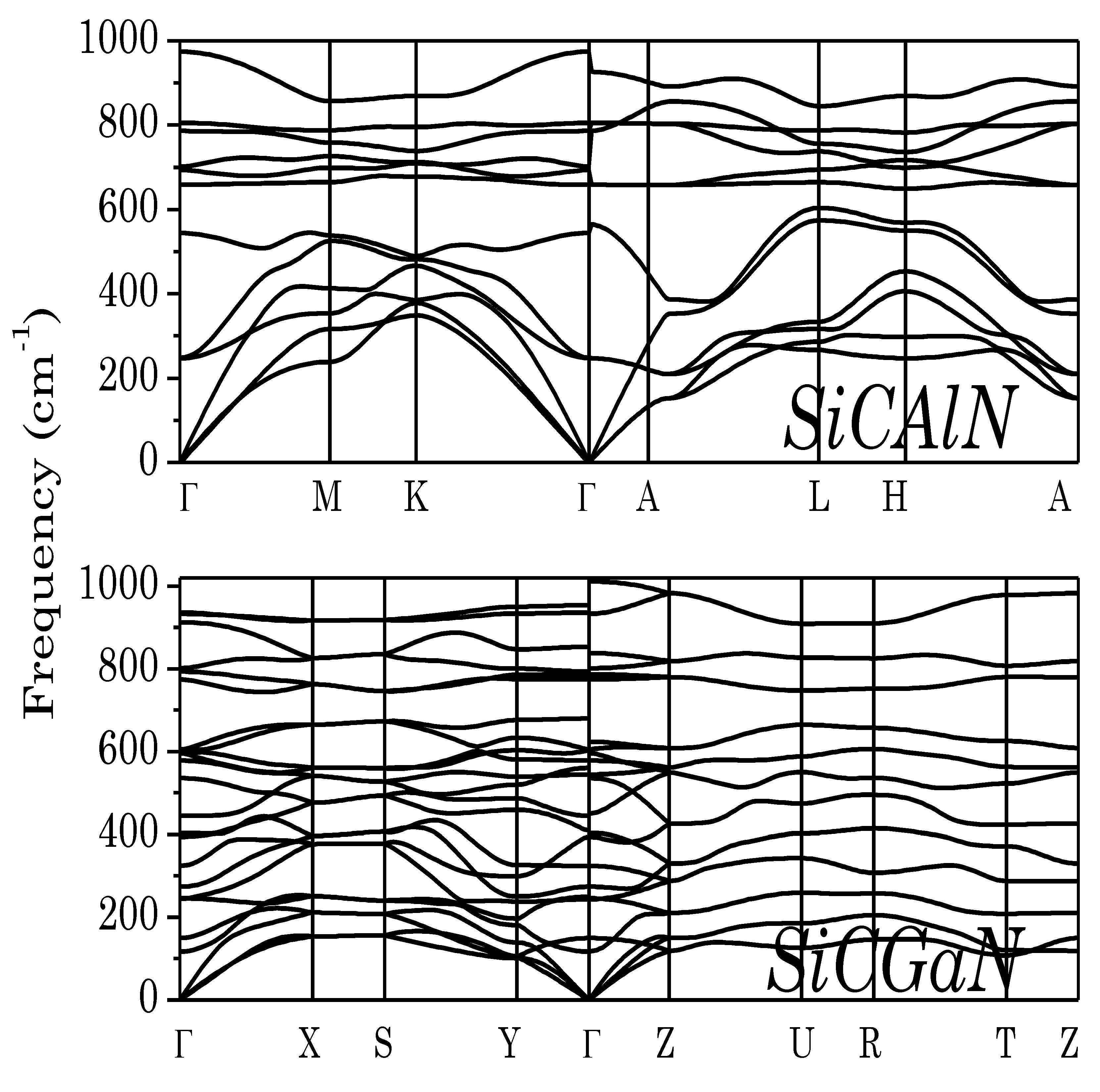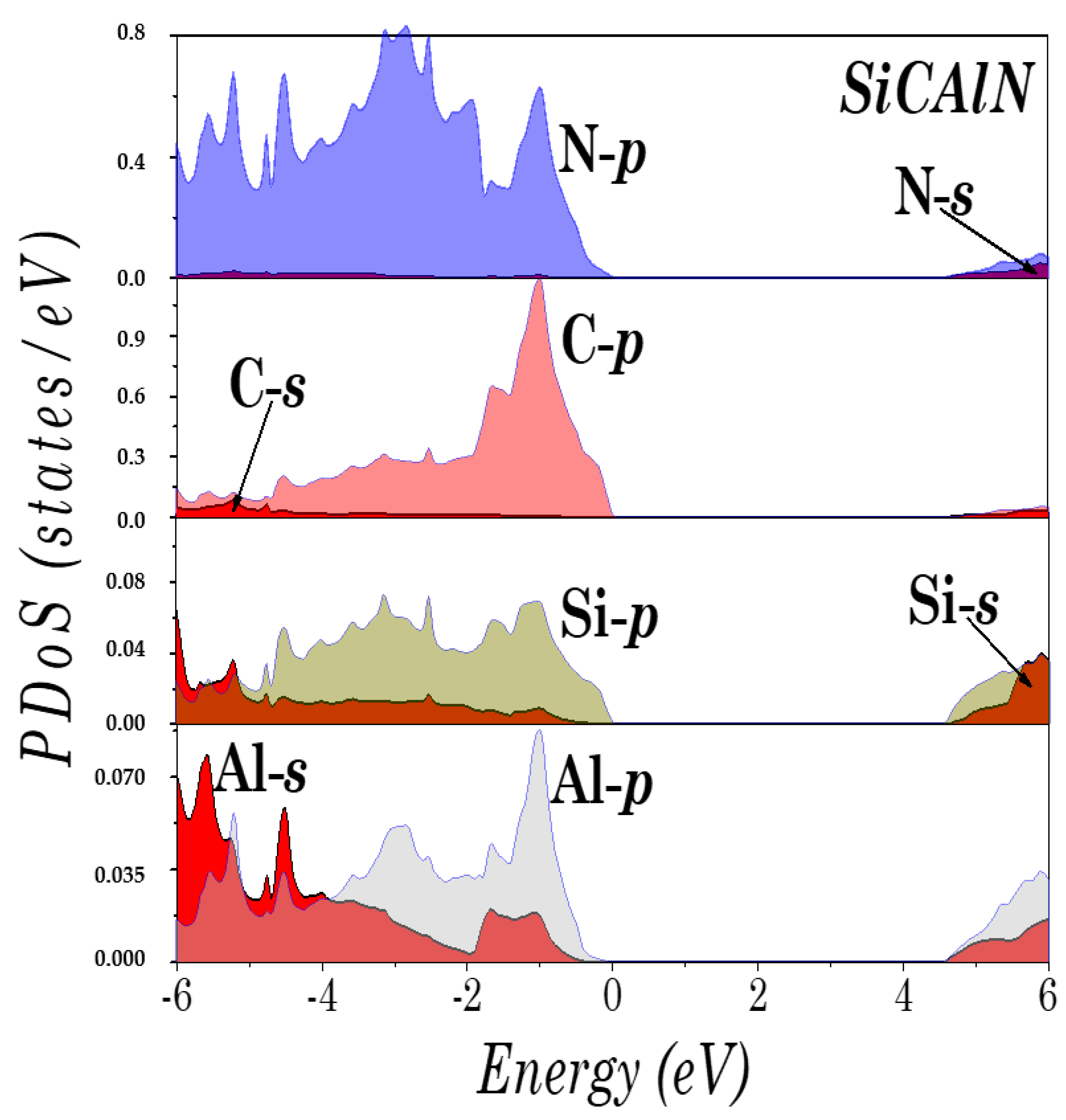Ground-State Structure of Quaternary Alloys (SiC)1−x (AlN)x and (SiC)1−x (GaN)x
Abstract
1. Introduction
2. Computational Methods
3. Results and Discussion
4. Conclusions
Author Contributions
Funding
Institutional Review Board Statement
Informed Consent Statement
Data Availability Statement
Acknowledgments
Conflicts of Interest
References
- Liao, Y.; Chen, T.; Wang, J.; Cai, W.; Ando, Y.; Yang, X.; Watanabe, H.; Tanaka, A.; Nitta, S.; Honda, Y.; et al. Improved device performance of vertical GaN-on-GaN nanorod Schottky barrier diodes with wet-etching process. Appl. Phys. Lett. 2022, 120, 122109. [Google Scholar] [CrossRef]
- Nomoto, K.; Li, W.; Song, B.; Hu, Z.; Zhu, M.; Meng, Q.; Protasenko, V.; Zhang, Z.; Pan, M.; Gao, X.; et al. Distributed polarization-doped GaN p–n diodes with near-unity ideality factor and avalanche breakdown voltage of 1.25 kV. Appl. Phys. Lett. 2022, 120, 122111. [Google Scholar] [CrossRef]
- Meneghini, M.; De Santi, C.; Abid, I.; Buffolo, M.; Cioni, M.; Khadar, R.A.; Nela, L.; Zagni, N.; Chini, A.; Medjdoub, F.; et al. GaN-based power devices: Physics, reliability, and perspectives. J. Appl. Phys. 2021, 130, 181101. [Google Scholar] [CrossRef]
- Zhang, H.; Yan, J.; Ye, Z.; Shi, F.; Piao, J.; Wang, W.; Gao, X.; Zhu, H.; Wang, Y.; Liu, Y.; et al. Monolithic GaN optoelectronic system on a Si substrate. Appl. Phys. Lett. 2022, 121, 181103. [Google Scholar] [CrossRef]
- Kaminska, A.; Koronski, K.; Strak, P.; Wierzbicka, A.; Sobanska, M.; Klosek, K.; Nechaev, D.V.; Pankratov, V.; Chernenko, K.; Krukowski, S.; et al. Defect-related photoluminescence and photoluminescence excitation as a method to study the excitonic bandgap of AlN epitaxial layers: Experimental and ab initio analysis. Appl. Phys. Lett. 2020, 117, 232101. [Google Scholar] [CrossRef]
- AlQatari, F.; Sajjad, M.; Lin, R.; Li, K.-H.; Schwingenschlögl, U.; Li, X. Lattice-matched III-nitride structures comprising BAlN, BGaN, and AlGaN for ultraviolet applications. Mater. Res. Express 2021, 8, 086202. [Google Scholar] [CrossRef]
- Kobayashi, A.; Ueno, K.; Fujioka, H. Autonomous growth of NbN nanostructures on atomically flat AlN surfaces. Appl. Phys. Lett. 2020, 117, 231601. [Google Scholar] [CrossRef]
- Nigro, R.L.; Fiorenza, P.; Greco, G.; Schilirò, E.; Roccaforte, F. Structural and Insulating Behaviour of High-Permittivity Binary Oxide Thin Films for Silicon Carbide and Gallium Nitride Electronic Devices. Materials 2022, 15, 830. [Google Scholar] [CrossRef]
- Hsu, S.-M.; Chiou, S.-H.; Chi, C.-C.; Chen, B.-Y.; Ouyang, C. 3C-SiC-induced peak emission intensity in photoluminescence spectrum of SiC/SiO2 core–shell nanowires using first-principles calculations. AIP Adv. 2021, 11, 065214. [Google Scholar] [CrossRef]
- Kong, L.; Chai, C.; Song, Y.; Zhang, W.; Zhang, Z.; Yang, Y. Structural, elastic, electronic, and anisotropic properties of Pbca-SiC and Pbcn-SiC. AIP Adv. 2021, 11, 045107. [Google Scholar] [CrossRef]
- Fisicaro, G.; Bongiorno, C.; Deretzis, I.; Giannazzo, F.; La Via, F.; Roccaforte, F.; Zielinski, M.; Zimbone, M.; La Magna, A. Genesis and evolution of extended defects: The role of evolving interface instabilities in cubic SiC. Appl. Phys. Rev. 2020, 7, 021402. [Google Scholar] [CrossRef]
- Weingärtner, R.; Torres, J.A.G.; Elrenbach, O.; de la Puente, G.G.; De Zela, F.; Winnacker, A. Bandgap engineering of the amorphous wide bandgap semiconductor (SiC)1−x(AlN)x doped with terbium and its optical emission properties. Mater. Sci. Eng. B 2010, 174, 114. [Google Scholar] [CrossRef]
- Ramazanov, S.M.; Kurbanov, M.K.; Safaraliev, G.K.; Bilalov, B.A.; Kargin, N.I.; Gusev, A.S. Structural properties of the epitaxial (SiC)1−x(AlN)x solid solution films fabricated by magnetron sputtering of SiC-Al composite targets. Tech. Phys. Lett. 2014, 40, 300–302. [Google Scholar] [CrossRef]
- Kern, R.S.; Rowland, L.B.; Tanaka, S.; Davis, R.F. Solid solutions of AlN and SiC growthn by plasma-asisted gas-source molecular beam epitaxy. J. Mater. Res. 1993, 7, 1477. [Google Scholar] [CrossRef]
- Roucka, R.; Tolle, J.; Chizmeshya, A.V.G.; Crozier, P.A.; Poweleit, C.D.; Smith, D.J.; Tsong, I.S.T.; Kouvetakis, J. Low-temperature epitaxial growth of the quaternary wide band gap semiconductor SiCAlN. Phys. Rev. Lett. 2002, 88, 206102. [Google Scholar] [CrossRef]
- Huang, S.; Xu, S.; Long, J.; Dai, Z.; Sun, Y. synthesis and property study of nanoparticles quaternary semiconductor SiCAlN films with co-sputtering under low temperature. Sur. Rev. Lett. 2005, 3, 397. [Google Scholar] [CrossRef]
- Tang, Y.-H.; Tsai, M.-H. Electronic structures of wide-band-gap (SiC)1−x(AlN)x quaternary semiconductors. Appl. Phys. Lett. 2005, 97, 103702. [Google Scholar] [CrossRef]
- Liu, Z.Q.; Ni, J. The electronic properties of SiCAlN quaternary compounds. Eur. Phys. J. B 2007, 59, 29–34. [Google Scholar] [CrossRef]
- Burton, B.P.; Demers, S.; van de Walle, A. First principles phase diagram calculations for the wurtzite-structure quasibinary systems SiC-AlN, SiC-GaN and SiC-InN. J. Appl. Phys. 2011, 110, 023507. [Google Scholar] [CrossRef]
- Jain, A.; Ong, S.P.; Hautier, G.; Chen, W.; Richards, W.D.; Dacek, S.; Cholia, S.; Gunter, D.; Skinner, D.; Ceder, G.; et al. Commentary: The Materials Project: A materials genome approach to accelerating materials innovation. Appl. Mater. 2013, 1, 011002. Available online: https://www.materialsproject.org (accessed on 5 February 2022). [CrossRef]
- Hautier, G.; Fischer, C.; Ehrlacher, V.; Jain, A.; Ceder, G. Data mined ionic substitutions for the discovery of new compounds. Inorg. Chem. 2011, 50, 656–663. [Google Scholar] [CrossRef] [PubMed]
- Hohenberg, P.; Kohn, W. Inhomogeneous electron gas. Phys. Rev. 1964, 136, B864. [Google Scholar] [CrossRef]
- Giannozzi, P.; Baroni, S.; Bonini, N.; Calandra, M.; Car, R.; Cavazzoni, C.; Ceresoli, D.; Chiarotti, G.; Cococcioni, M.; Dabo, I.; et al. QUANTUM ESPRESSO: A modular and open-source software project for quantum simulations of materials. J. Phys. Condens. Matter 2009, 21, 395502. [Google Scholar] [CrossRef]
- Perdew, J.P.; Zunger, A. Self-interaction correction to density-functional approximations for many-electron systems. Phys. Rev. B 1981, 23, 5048. [Google Scholar] [CrossRef]
- Corso, A.D. Projector augmented-wave method: Application to relativistic spin-density functional theory. Phys. Rev. B 2010, 82, 075116. [Google Scholar] [CrossRef]
- Monkhorst, H.J.; Pack, J.D. Special points for Brillouin-zone integrations. Phys. Rev. B 1976, 13, 5188. [Google Scholar] [CrossRef]
- Baroni, S.; de Gironcoli, S.; Corso, A.D.; Giannozzi, P. Phonons and related crystal properties from density-functional perturbation theory. Rev. Mod. Phys. 2001, 73, 515. [Google Scholar] [CrossRef]
- Blaha, P.; Schwarz, K.; Madsen, G.K.H.; Kvasnicka, D.; Luitz, J. WIEN2k: An Augmented Plane Wave Plus Local Orbitals Program for Calculating Crystal Properties; Vienna University of Technology: Vienna, Austria, 2001. [Google Scholar]
- Tran, F.; Blaha, P. Accurate band gaps of semiconductors and insulators with a semilocal exchange-correlation potential. Phys. Rev. Lett. 2009, 102, 226401. [Google Scholar] [CrossRef] [PubMed]
- Vurgaftman, I.; Meyer, J.R.; Ram-Mohan, L.R. Band parameters for III–V compound semiconductors and their alloys. J. Appl. Phys. 2001, 89, 5815. [Google Scholar] [CrossRef]
- Xia, Q.; Xia, H.; Ruoff, A.L. Pressure-induced rocksalt phase of aluminum nitride: A metastable structure at ambient condition. J. Appl. Phys. 1993, 73, 8198–8200. [Google Scholar] [CrossRef]
- Schultz, H.; Thiemann, K.H. Structure parameters and polarity of the wurtzite type compounds Sic—2H and ZnO. Solid State Commun. 1979, 32, 783–785. [Google Scholar] [CrossRef]
- Carnahan, R.D. Elastic properties of silicon carbide. J. Am. Ceram. Soc. 1968, 51, 223–224. [Google Scholar] [CrossRef]
- Martins, J.L.; Zunger, A. Stability of ordered bulk and epitaxial semiconductor alloys. Phys. Rev. Lett. 1986, 56, 1400. [Google Scholar] [CrossRef] [PubMed]
- Born, M.; Huang, K. Dynamical Theory of Crystal Lattices; Clarendon: Oxford, UK, 1956. [Google Scholar]
- Chen, X.Q.; Niu, H.Y.; Liu, D.Z.; Li, Y.Y. Modeling hardness of polycrystalline materials and bulk metallic glasses. Intermetallics 2011, 19, 1275–1281. [Google Scholar] [CrossRef]
- Tanaka, S.; Kohyama, M. Ab initio calculations of the 3C-SiC (111)/Ti polar interfaces. Phys. Rev. B 2001, 64, 235308. [Google Scholar] [CrossRef]
- Zhukovskii, Y.F.; Pugno, N.; Popov, A.I.; Balasubramanian, C.; Bellucci, S. Influence of F centres on structural and electronic properties of AlN single-walled nanotubes. J. Phys. Cond. Matter. 2007, 19, 395021. [Google Scholar] [CrossRef]





| a (Å) | c/a | B0 (GPa) | B’0 | |
|---|---|---|---|---|
| AlN | 3.087 (3.112) a | 1.600 (1.600) a | 210.5 (185) b | 3.1 |
| GaN | 3.160 (3.189) a | 1.630 (1.626) a | 184.7 (188) b | 4.2 |
| SiC | 3.055 (3.079) c | 1.641 (1.641) c | 145.6 (223) d | 3.8 |
| a (Å) | b/a | c/a | B0 (GPa) | B’0 | |
|---|---|---|---|---|---|
| SiCAlN(P3m1) | 3.071 | 1.625 | 216.4 | 3.9 | |
| SiCGaN(Pmn21) | 3.162 | 1.840 | 1.658 | 170.5 | 3.2 |
| ΔH(St) (eV/atom) | ΔH(Chem) (eV/atom) | ΔH (eV/atom) | |
|---|---|---|---|
| SiCAlN | −0.087 | 0.155 | 0.067 |
| SiCGaN | 0.046 | 0.136 | 0.183 |
| C11 | C12 | C22 | C13 | C23 | C33 | C44 | C55 | C66 | |
|---|---|---|---|---|---|---|---|---|---|
| SiCAlN | 457.9 | 125.4 | 86.5 | 447.2 | 166.3 | ||||
| SiCGaN | 356.3 | 84.2 | 156.8 | 122.4 | 153.0 | 331.1 | 131.6 | 106.9 | 69.6 |
| E (GPa) | G (GPa) | ν | |
|---|---|---|---|
| SiCAlN | 364.3 | 149.2 | 0.22 |
| SiCGaN | 212.9 | 83.5 | 0.28 |
Disclaimer/Publisher’s Note: The statements, opinions and data contained in all publications are solely those of the individual author(s) and contributor(s) and not of MDPI and/or the editor(s). MDPI and/or the editor(s) disclaim responsibility for any injury to people or property resulting from any ideas, methods, instructions or products referred to in the content. |
© 2023 by the authors. Licensee MDPI, Basel, Switzerland. This article is an open access article distributed under the terms and conditions of the Creative Commons Attribution (CC BY) license (https://creativecommons.org/licenses/by/4.0/).
Share and Cite
Menad, A.; Ferhat, M.; Zaoui, A. Ground-State Structure of Quaternary Alloys (SiC)1−x (AlN)x and (SiC)1−x (GaN)x. Micromachines 2023, 14, 250. https://doi.org/10.3390/mi14020250
Menad A, Ferhat M, Zaoui A. Ground-State Structure of Quaternary Alloys (SiC)1−x (AlN)x and (SiC)1−x (GaN)x. Micromachines. 2023; 14(2):250. https://doi.org/10.3390/mi14020250
Chicago/Turabian StyleMenad, Abdelkader, Mohamed Ferhat, and Ali Zaoui. 2023. "Ground-State Structure of Quaternary Alloys (SiC)1−x (AlN)x and (SiC)1−x (GaN)x" Micromachines 14, no. 2: 250. https://doi.org/10.3390/mi14020250
APA StyleMenad, A., Ferhat, M., & Zaoui, A. (2023). Ground-State Structure of Quaternary Alloys (SiC)1−x (AlN)x and (SiC)1−x (GaN)x. Micromachines, 14(2), 250. https://doi.org/10.3390/mi14020250





